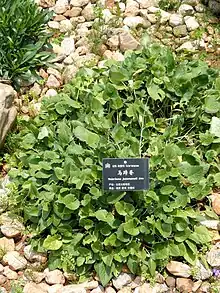Valeriana jatamansi
Valeriana jatamansi, formerly known as Valeriana wallichii, is a rhizome herb of the genus Valeriana and the family Valerianaceae also called Indian Valerian or Tagar-Ganthoda, not to be confused with ganthoda, the root of Indian long pepper. It is an herb useful in Ayurvedic medicine used as an analeptic, antispasmodic, carminative, sedative, stimulant, stomachic, and nervine.[2]
| Valeriana jatamansi | |
|---|---|
 | |
| Scientific classification | |
| Kingdom: | Plantae |
| Clade: | Tracheophytes |
| Clade: | Angiosperms |
| Clade: | Eudicots |
| Clade: | Asterids |
| Order: | Dipsacales |
| Family: | Caprifoliaceae |
| Genus: | Valeriana |
| Species: | V. jatamansi |
| Binomial name | |
| Valeriana jatamansi Jones ex Roxb. | |
| Synonyms[1] | |
| |
The genus Valeriana, with about 200 species, belongs to the family Valerianaceae and has a distribution throughout the world. The Indian Valerian has long been used in Ayurveda (Charak Samhita and Susruta) and Unani systems of medicine, which describe its use in obesity, skin disease, insanity, epilepsy and snake poisoning. The crude drugs from roots/ rhizomes and Valerian derived phytomedicines are used as mild sedatives in pharmaceutical industry. The activity is largely attributed to the presence of valepotriates.
General distribution
Valeriana jatamansi is native to India, Nepal, Pakistan and China. As an important substitute for the European V. officinalis, it has been traditionally used in treatment of sleep problems, obesity, nervous disorders and snake poisoning and skin diseases. Uttarakhand, part of Indian North western Himalaya, represents a mountainous region that encompasses agroclimatic conditions ranging from tropical to alpine and, thus, possesses a rich biodiversity. Valeriana, the major genus in the family Valerianaceae, is characterized by perennials that have three stamens without spurs on the slightly swollen base of the corolla, with a short and often strong-smelling root stalk. Strachey reported in 1918 the occurrence of five Valeriana species, V. dioica L., V. pyrolaefolia, V. stracheyi, V. jatamansi DC., and V. hardwickii, at elevations ranging from 1500 ± 4300 m. A re-investigation of the morphology, distribution, and biodiversity of the Indian Valerianaceae, however, showed a total of 16 species/subspecies, of which six, namely V. wallichii DC. (V. jatamansi), V. himalayana (V. dioica L.), V. pyrolaefolia, V. mussooriensis, V. hardwickii. var. hardwickii, and V. hardwickii. var. arnottiana (Wt. C.B.) occur in Uttarakhand, Himalaya.
References
- "Valeriana jatamansi Jones ex Roxb". Plants of the World Online. Kew Science. Retrieved 2021-07-17.
- Mathela, Chandra S, Tiwari, Mamta, Sammal, Subhash S, Chanotiya, Chandan S "Valeriana wallichii DC, a New Chemotype from Northwestern Himalaya" Journal of Essential Oil Research, Nov-Dec 2005
- C.S. Mathela, C.S. Chanotiya, S.S. Sammal, A.K. Pant and S. Pandey. "Compositional diversity of terpenoids in the Himalayan Valeriana genera", Chemistry & Biodiversity 2005, 2, 1174–1182.
- C.S. Mathela, M. Tewari, S.S. Sammal and C.S.Chanotiya. "Valeriana wallichii DC, a new Chemotype from Northwestern Himalaya", Journal of Essential Oil Research 2005, 17, 672–675.
- C. S. Mathela, C.S. Chanotiya, Shalini Sati, S. S. Sammal and Victor Wray. "Epoxysesquithujene, a novel sesquiterpenoid from Valeriana hardwickii var. hardwickii", Fitoterapia 2007, 78, 279–282.
- C. S. Mathela, R. C. Padalia and C. S. Chanotiya. 2009. "Kanokonyl Acetate-Rich Indian Valerian from Northwestern Himalaya". Nat Prod Commun. 2009, 4(9):1253-1256.